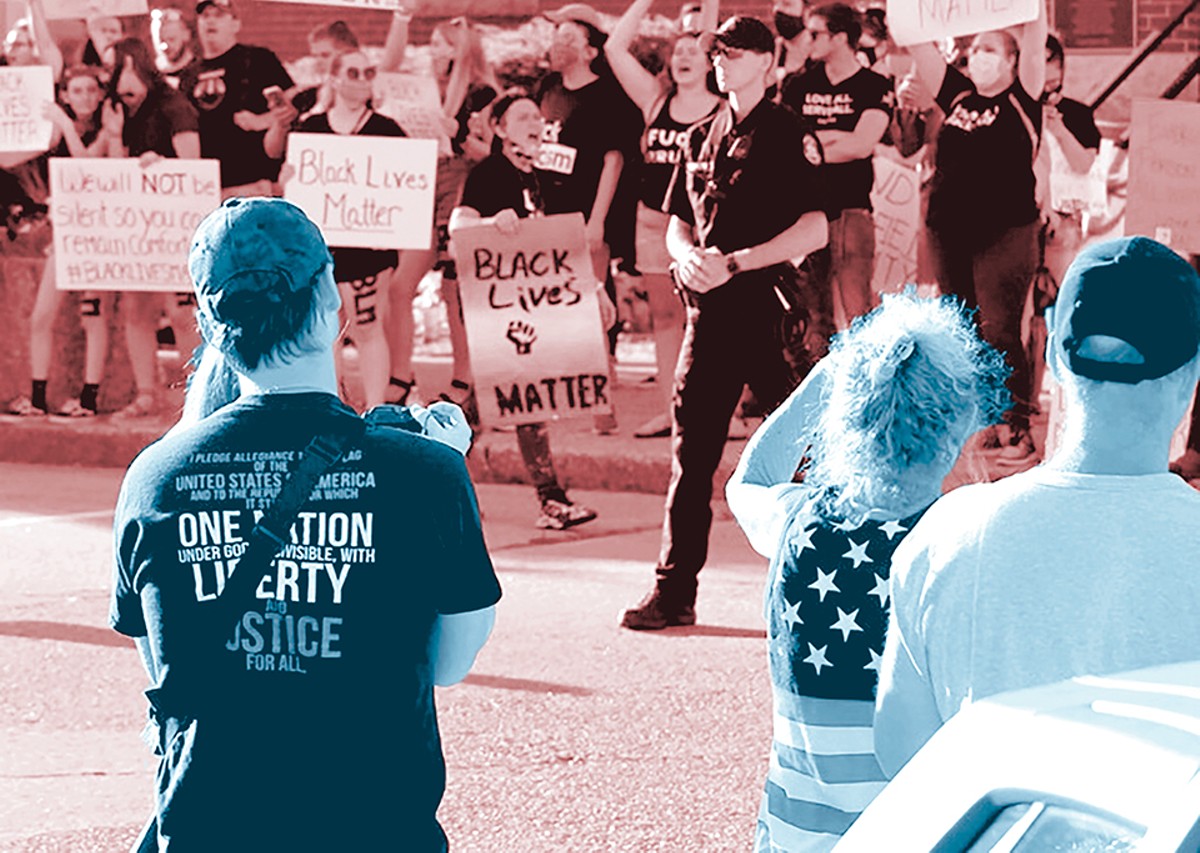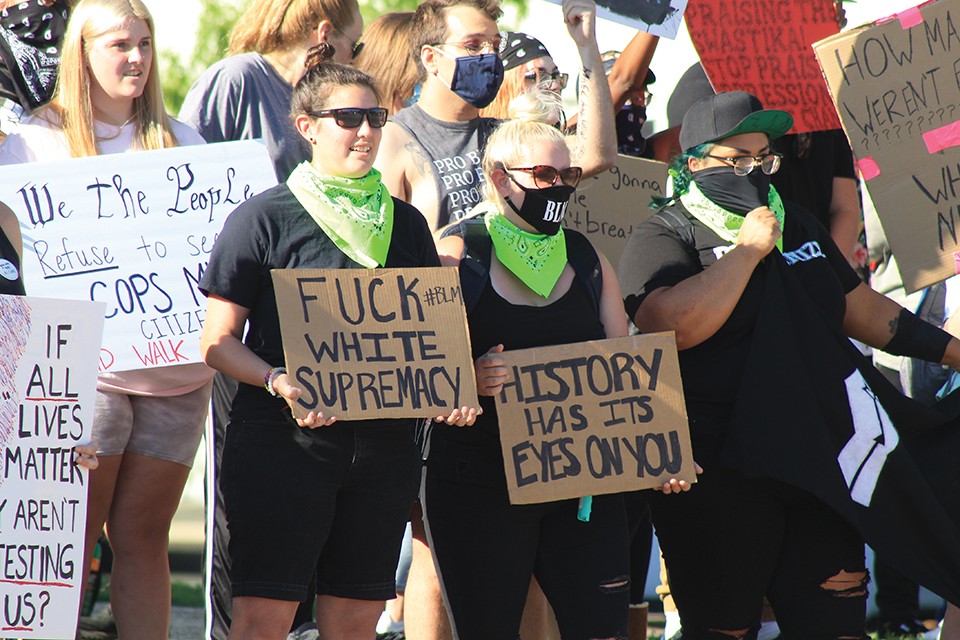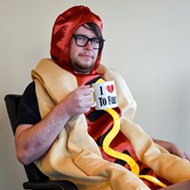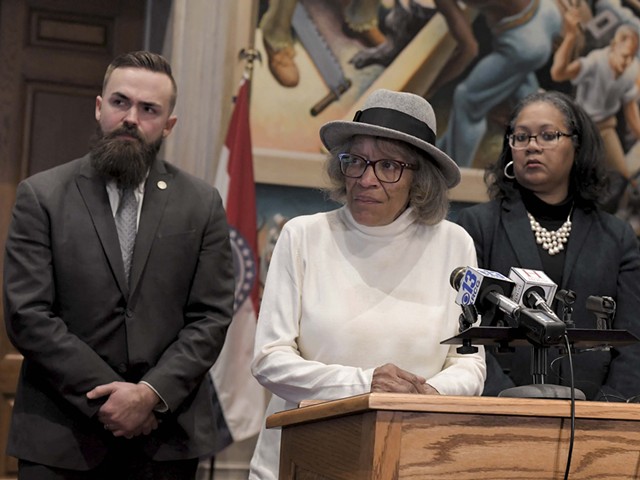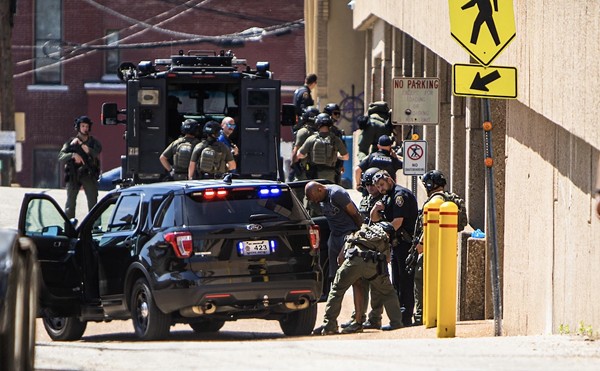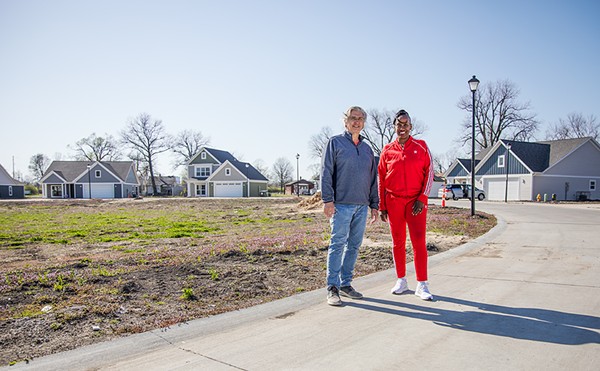Main Street Memories, a small shop in Fredericktown, is best known as a vintage and antique gift store. But, in a pinch, it can also serve as a perfectly fine sniper's nest.
That's the impression one might get from the scene that played out on the evening of June 24, when a group of protesters aiming to shed light on racism in the small southeast Missouri city were met by a larger group of counterprotesters — many armed to the teeth.
Photos and video from the event show that gun-wielding townspeople were joined by members of the Three Percenters — a group described by the Southern Poverty Law Center as an anti-government militia — dressed in military fatigues and tactical vests. They carried rifles, pistols and zip ties similar to the ones used by law enforcement in lieu of handcuffs. A man spotted on the roof of the antique shop even had a suppressor on his gun.
And on the other side, ostensibly in defense of the protesters, Hawaiian-shirt-sporting Boogaloo Bois, a loosely organized group that believes a second American civil war is impending, carried their own rifles and tactical gear.
Not everyone had guns, though. Some townsfolk brought bladed weapons. At least two arrived on the scene with broadswords. Others wielded two-by-fours.
For Frederick Dorsey Jr., the 21-year-old who had organized the protest, the weaponry was a little much. But it was nothing compared to the blatant racism hurled at him by many of those same armed townsfolk.
"A lot of Confederate flags," Dorsey, whose mother is white and whose father is Black, says of the scene. "And I also saw people threaten to hang me from a noose. A few people were making monkey gestures and telling me I needed to go back to my own community, when I've lived in Fredericktown for sixteen years. I got called many racial slurs. And then my own mother was protesting against me."
In videos, counterprotesters can be seen imitating monkeys and making gestures with their hands that imply hanging by a noose. When Cheyenne Devereaux, a Black drag queen based in St. Louis, made her way over to the counterprotesters' side of the street, a voice could be heard saying, "Whatever that thing is, arrest it."
"I'm a drag queen," Devereaux replied calmly.
"You're a drag alright," the man responded, before another man said, "String it up. String it up from the courthouse."
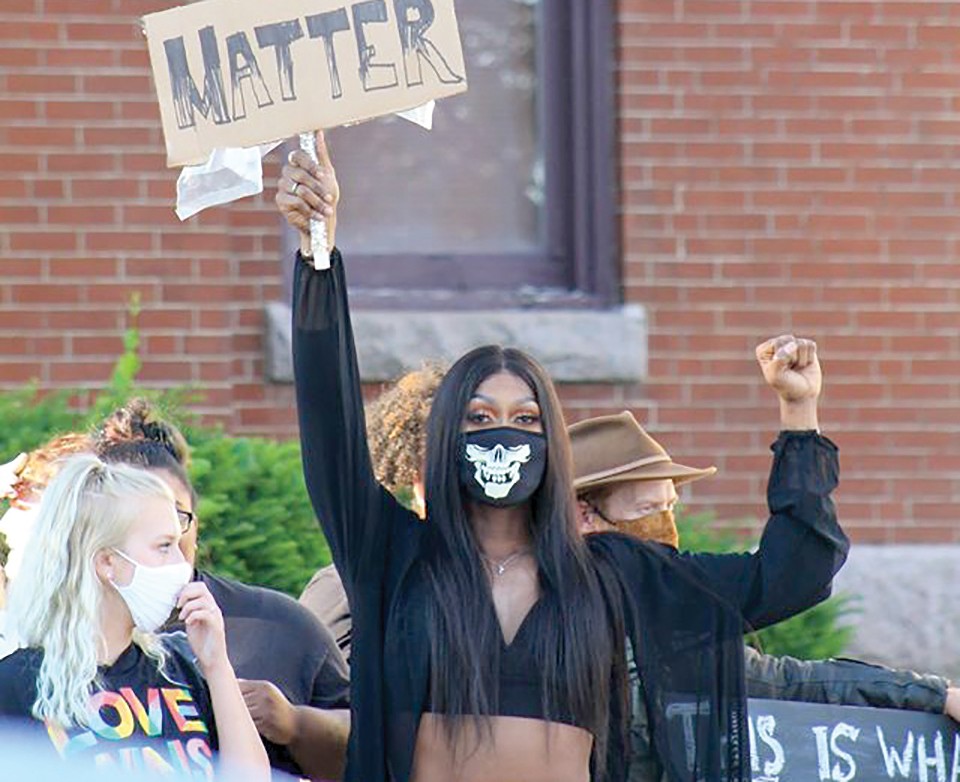
Meanwhile, a Jeep circled the scene for upwards of three hours, blasting a David Allan Coe song titled "N*gger Fucker," whose lyrical content is just as reprehensible as its name implies.
Perhaps unsurprisingly, many of the counterprotesters wore Trump apparel and waved flags in support of the president.
"The counterprotest was supposed to be a 'Back the Blue' protest. But it turned into a Trump rally somehow," Dorsey says. "I still don't understand how that happened. [My] protest wasn't even about the police department; it was just to show how racist Fredericktown is.”
It would seem that Dorsey made his point. Still, witnessing his own family shout threats and insults at him was more than a little surreal.
"Me and my mom have never had a close relationship. Before this protest I haven't seen her in several years," Dorsey, who lives with his dad, says. "And she was on the other side, I guess you could call it the Back the Blue, pro-Trump side, saying that I was just doing all this to show my ass, and I'm putting my life at risk and everything. And then my stepdad and his kids said they were gonna kill me because I'm doing all this. He kept calling me stupid and saying I needed to grow up. And I was like, if anything, this is the most grown-up thing I've done.
"I didn't say anything back, because it wasn't worth my time, because I feel like what I'm doing is right," Dorsey adds. "And it's much needed."
Fredericktown is a small city located about an hour and a half south of St. Louis, in the northeastern foothills of the St. Francois Mountains. The town's early history saw it as a mining hub, with mines just east of the city that were, at one point, the largest source of lead in the United States.
It is the county seat of Madison County, with just under 4,000 people and a population that is 96 percent white, according the U.S. Census Bureau. The town contains two elementary schools, one middle school and one high school.
In some ways, Fredericktown is familiar to Adam Hamlin, 34, an independent journalist who was shooting photos at the surreal scene on June 24. Hamlin grew up in Imperial, a similarly small and predominantly white town just an hour north in Jefferson County. He still lives in JeffCo today, but no longer in Imperial. He reasons that his experience gives him a unique view into the racism that can sometimes be pervasive in small-town America.
“I come from a little-bitty town myself. I come from Imperial, Missouri, which is really little. I grew up there most of my entire life, but especially throughout the entire '90s,” Hamlin says. "I know how a lot of these little towns often behave. And I didn't go to these places looking for that, but they definitely haven't hidden it either.”
In the past, Hamlin photographed nature — a far more peaceful affair. But ever since the events of Charlottesville's "Unite the Right" rally in 2017 that ended in the killing of Heather Heyer by a white supremacist who deliberately drove his car into a crowd of peaceful protesters, Hamlin has felt compelled to document protests. He's also trained as a street medic, just in case.
"I figured if I could do anything, I could bring some medic supplies," Hamlin says. “But I could also capture what was happening, so that way there could never really be a question about what's going on."
In keeping, Hamlin has spent years attending and documenting protests across the region — lately, many of them in the small towns in southeast Missouri. He notes that oftentimes those opposed to Black Lives Matter protests in more rural communities claim they don't want to see their towns looted and pillaged — a familiar refrain for anyone who has seen the comment section on a news story in the past couple months. But Hamlin doesn't buy it.
"That's the line that they give — that they are just protecting their community — but it's hard to believe that," he says. "The majority of these protesters that show up in these little rural towns also live there. So they're not looking to destroy anything at all, and I know that the counterprotesters also know that. But the counterprotesters are also the kind of people who generally are gonna have signs on their house that say, 'We don't call cops' or things like that. So they can say that they're wanting to protect their community all they want, but I think that they're kind of looking for a show or something that they can get in on in that manner."
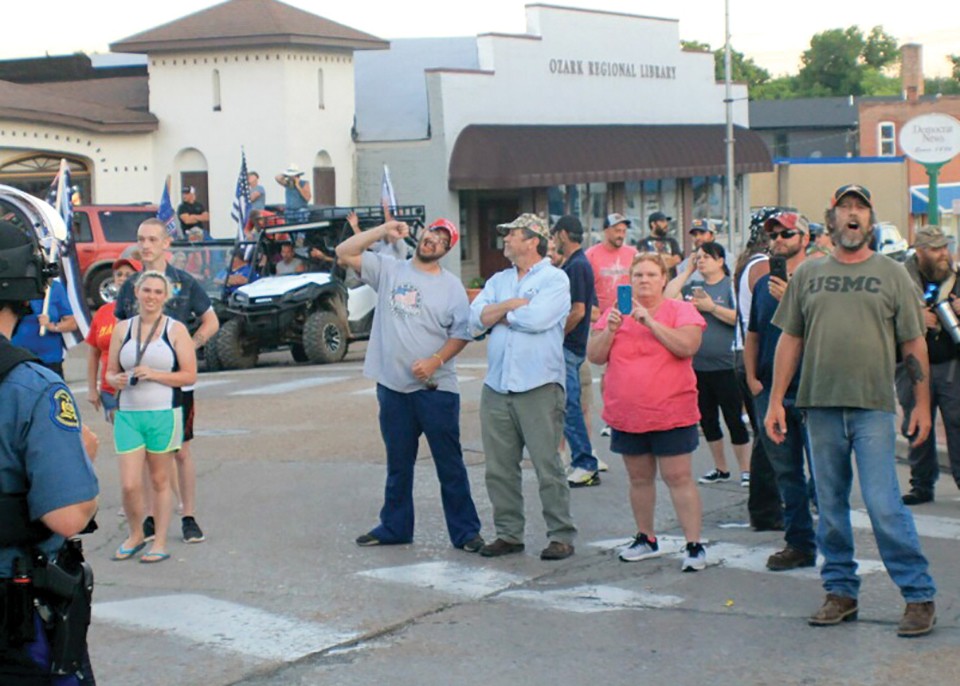
Hamlin has seen counterprotesters behave in all sorts of ways that don't imply fear or defense, but rather a kind of political theater. At a recent protest in Perryville, he says, a couple drove around for hours with a Trump flag — so long that they had to switch seats at one point — and threw pacifiers at the protesters to imply they were babies. At another recent protest in Park Hills, Hamlin watched a group of protesters get into a car and begin to drive away. Counterprotesters chased the car on foot.
Still, Hamlin says what he saw in Fredericktown on June 24 was the most shocking display he's seen since he got started.
"It was pretty gross, all things considered," he says. "Like, Perryville had an actual Nazi who came out and Sieg Heiled and shouted 'white power' a bunch, and Fredericktown was still worse than that."
At one point in Fredericktown, Hamlin says, a man was shouting threats and taunts so forcefully that his teeth actually flew out of his mouth.
"He went to shout something, but instead of the word coming out, his top fake teeth came out. Like actually hit the ground," Hamlin says. "He just picked 'em up and put 'em back in his pocket."
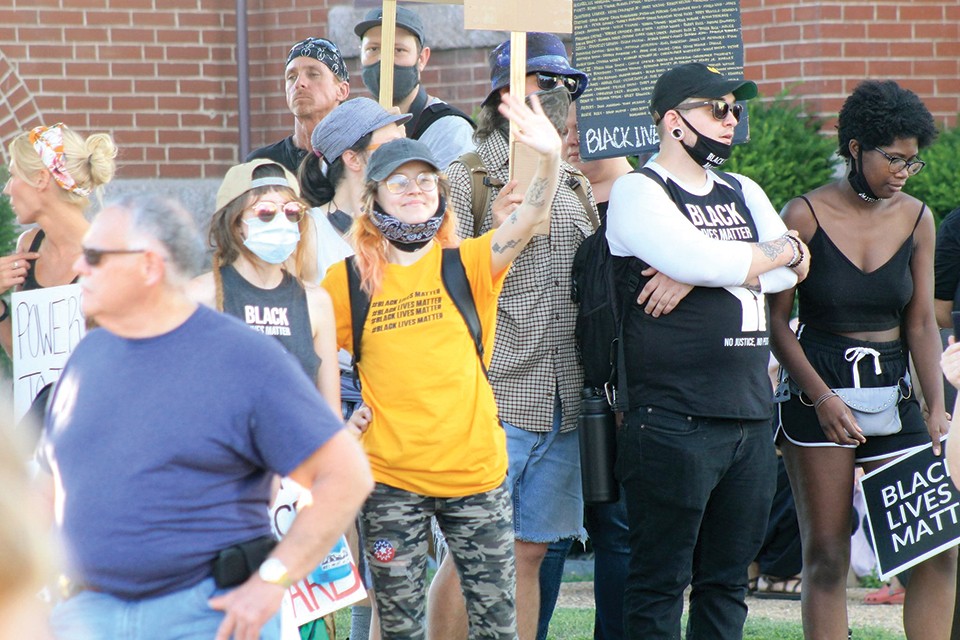
As widespread protests have continued across the nation in response to George Floyd's killing by police in Minneapolis, the already stark political divisions in the U.S. have become even more pronounced. On the right, this has led to a demonization of the predominantly left-wing protesters, enthusiastically stoked by President Trump, who has referred to them as "thugs," "vandals," "anarchists" and even "terrorists."
Fear of BLM and antifa, the latter of which Trump has outright labeled a "terrorist organization," has led to some wild fever dreams in rural and suburban communities that there will soon be riots and looting on the streets of their towns. But that fear has also been deliberately sown by neo-Nazi groups who have even gone so far as to impersonate their anti-fascist rivals online in order to further push the idea that dangerous mobs are planning to descend upon small-town America and wreak havoc.
In early June, Twitter suspended a newly created account with the username @ANTIFA_US after it posted a rather alarming tweet: “Tonight's the night, Comrades," the tweet read, accompanied with a brown fist emoji. "Tonight we say ‘Fuck The City’ and we move into the residential areas... the white hoods.... and we take what's ours …”
Twitter swiftly moved to suspend the account for violating its rules against the incitement of violence. After an investigation, the company linked the account to the white nationalist group Identity Evropa, an organization designated as a hate group by the Southern Poverty Law Center. Identity Evropa was also involved in organizing the deadly "Unite the Right" rally in Charlottesville.
By the time Twitter suspended the account, though, the genie was already out of the bottle. The message was retweeted hundreds of times and popped up in several online news stories from right-leaning publications. Screenshots of the tweet made their way onto Instagram and Facebook, where they spread unabated.
Social media was flooded around this time with similar stories of antifa "bussing in" rioters to small towns — claims that were wholly unsubstantiated. On June 1, as reported by the Associated Press, the sheriff's office in Payette County, Idaho, a rural county with a population of about 24,000, took to Facebook to address the substantial number of phone calls it had received tipping the department off to an alleged antifa invasion set to hit their community.
"The Payette County Sheriff's Office has been monitoring social media posts that have stated FALSE information," reads a statement on Facebook. "The original post (with false information) states: ‘Family and friends in Idaho. We were told by our Congressman that Antifa has sent a plane load of their people into Boise and three bus loads from Seattle into the rural areas. The sheriff in Payette has already spotted some of them. We were warned to lock our doors and our guns. We think they will stay in the larger communities but it is best to be prepared.'
"The Payette County Sheriff's Office has not had contact with and has not verified that Antifa is in Payette County. The Payette County Sheriff's Office has not given any specific warnings to our citizens about Antifa or other organizations. The information in this social media post is not accurate."
Obviously, planes and buses full of antifa "terrorists" did not show up in Payette County. But the disinformation was part of a pattern, with the AP noting similar false flags in Toms River, a New Jersey suburb; Sioux Falls, South Dakota; and Milan, Michigan. The Sioux Falls warning even used identical language as the one debunked by Payette County.
Given the storm of misinformation, it might make some sense that the scene in Fredericktown on June 24 featured a whole lot of guns.
That day's "Back the Blue" counterprotest was organized by a Fredericktown resident named John Johnson as a direct response to Dorsey's efforts to highlight the existence of racism in his city. Dorsey's assessment of Johnson is succinct.
"He's a shit disturber," Dorsey says.
Johnson's public Facebook page seems to bear that out. On June 27, just a few days after the protest, Johnson changed his listed profession on the site to indicate that he is the social media manager for the Southern Poverty Law Center (he is not). About a week and a half after that, on July 8, he posted a message to his followers that might explain the imaginary career change: "If you have your work place listed on Facebook remove it," he wrote, adding in a comment, "People are getting fired from their jobs. BLM is stalking Facebook pages and doxxing individuals. They will contact your employer and try to get you fired."
Looking through Johnson's social media posts, a few things become clear. Johnson seems to align politically with the right — there are multiple posts in support of Donald Trump, as well as many that show disdain for Democrats.
“Not all Republicans are Christian but I can be sure to know that no Democrats are," he wrote on July 17.
Johnson's page also promotes QAnon conspiracies that allege widespread child sexual abuse by celebrities, Democrats and members of the media — an unsubstantiated fringe theory that claims Trump is working behind the scenes to lock up all of the perpetrators and free the children. He frequently derides protesters and the Black Lives Matter movement, appears to have no problem with the Confederate flag but big problems with being asked to wear a mask in public, and isn't shy to mention that he carries a gun.
“Why do I carry? Because people are crazy and you never bring a knife to a gun fight," he wrote when sharing a story about a stabbing spree on a New York subway. "Act fast and toss brass."
According to Dorsey and Hamlin, Johnson had his own PA system at the June 24 protest, and he shared many of his views with those assembled.
"He listed a lot of — most of what he was saying was more QAnon stuff, but it was definitely geared in a way to rile up the protesters for sure," Hamlin says.
"I don't believe necessarily that the man is as misogynistic as some of the things he was saying," Hamlin adds.
“The one thing that really stuck with me," Dorsey says, "he was like, ‘Why doesn't everyone just stop and we all can get ice cream?’ And he said, ‘You guys can get the chocolate and we can get the vanilla.’”
In a post on June 26 — just two days after those dueling protests in Fredericktown — Johnson seems to offer a more thoughtful take on race relations in America than those related to ice cream. He mentions that he was asked to watch Ava DuVernay's award-winning 2016 documentary 13th, which makes the case that slavery was never really abolished but instead kept alive through mass incarceration which targets black people and makes them prisoners. They then, through very specific language in the Constitution's Thirteenth Amendment, can be made to work for corporations for free.
“So someone asked me to watch the Netflix documentary 13th. Has anyone else watched this yet? The nation is stained with a past that was not fair to POC and I will say it was down right intolerant of individuals who were not white,” he writes. "I understand that the war on drugs could be seen as a war on blacks. Some drugs had heftier sentences while other drugs had lighter sentences. The idea was that the drugs that blacks used were criminalized heavier than those that were taken by whites [which] didn't carry as hefty of a prison term.

"I sat there thinking about it. I actually stopped watching the film and really wanted to wrap my head around the idea," he continues. "It wasn't just republicans who did it but it was also democrats. I sat there thinking what is the purpose of imprisoning, was it really about color or is it about class? Poor people tend to use drugs like meth, heroin, crack, and opioids but wealthy tend to use drugs like cocaine. I am not taking away from what they said but I often wonder if we are not divided by color but by wealth?”
One other post on Johnson's Facebook page lists a number with a Fredericktown area code and a photo of Johnson. It is styled to look like the "order now" screen of an infomercial.
For sale is "The Confidence of a Self-Entitled White Man" — a 30-day trial for only $19.99.
RFT called the number, and a man identifying himself as John said in a prerecorded voicemail message that he is the author of a book by that same name, which you can order by sending money to a Fredericktown address he lists. It's surely a joke — some more shit disturbed, some might say. RFT left repeated messages after the beep in an effort to contact Johnson, but we received no response.
Before the beep, though, Johnson wraps up the recording with his own message: "You have a great day, and remember — all lives matter."
Leticia Hindrichs didn't grow up in Fredericktown, but she didn't come from terribly far away.
"I grew up in a town a little bit further east of Fredericktown called Ste. Genevieve," she says, mentioning yet another southeast Missouri town with an overwhelmingly white population of around 4,000 people. "And I am a brown kid that grew up in that town, and I can tell you that blatant racism my whole life has been a thing. I've gotten derogatory terms thrown at me, I've gotten just not the consideration of my white friends beyond that. And then even going to Fredericktown — I played softball all through high school, and going to Fredericktown to do that, I was dealing with those same things there."
Hindrichs, 28, is one of the activists behind a fledgling group called Missouri Social Activism, or MOSA. The group consists of ten organizers, all from the area, that operate a private Facebook group with a membership of about 500. To date, they've organized six protests in southeast Missouri — two in Farmington, two in Fredericktown and two in Park Hills. Hindrichs says they usually bring out about 50 or so people.
Their motivations are pretty simple.
"I think it's just a general consensus that racism is bad, systematic racism is bad," Hindrichs explains. "And I know some of the people in our group haven't quite caught on to what all that entails, but I think it was just that emotional response to what happened with Minneapolis, what's going on all over the country, and we knew that we needed to stand up and do something. And eventually we found each other in the local groups, talking shit to other racists, you know. We talked within a group chat, and that's when we decided we needed to move forward with organizing things in that area."
Dorsey's first experience at a protest was a MOSA-organized event. Previously, he'd had little interest in politics or activism, but after attending one of the protests in Farmington, he soon joined as one of the group's organizers.
“Before all of this I always just kinda kept to myself. I didn't really care about the media or politics or anything," Dorsey says. "But I was at work and I seen on Facebook that they were hosting a Black Lives Matter protest in Farmington. And for some reason something inside of me said that I need to go. So I got off work, went straight up there, protested, and apparently I did really well, because so many people came up to me and were like, ‘We want you to lead the next one.' And I was like, ‘I don't know what I'm doing; this was the first protest I've ever been to.' I don't normally speak out in front of people. But apparently I'm a natural."
Dorsey decided that he wanted the first protest he organized to be in his hometown of Fredericktown. Though the counterprotest that was organized in response was billed as a "Back the Blue" event, Dorsey says his protest was not meant to be about policing at all — he just wanted to prove that racism was alive and well in the small town.
He says he saw pushback online from some in the community immediately upon announcing his plans.
"Whenever I first posted that I was doing this protest in Fredericktown, so many people were saying, like, ‘Racism is not a problem in this town,' and that I'm ‘just bringing racism and hate to this town,'" Dorsey says. "And they think that since Fredericktown is just a small community, they think that they're better than everyone and racism is not a problem and everything. Whereas I've been living here for sixteen years and I've been kicked out of stores. I've just been treated differently in this town solely based on my skin color. And if you look at me you couldn't even tell if I was mixed, if it wasn't for my hair. But I still get treated differently.
"So many people were saying that racism is not a problem," he continues. "But then I do this protest and I have two to 300 people on the other side literally calling me the N-word the whole entire time. How can you say that racism's not a problem in this town when people are just blatantly being dumb?"
The group plans to continue organizing protests in their communities for the foreseeable future. Hindrichs says they hope to eventually branch out into more community outreach endeavors, such as gathering school supplies for needy kids in the area and doing food drives. But meanwhile, they hope to educate people about the role racism plays in American society in general, and southeast Missouri in particular.
“I would say that our original mission statement, and what we hope for in the future, is just to be able to reach out to our community and educate on these systematic injustices and how they affect not only Black and indigenous people of color in our area, but how they also affect us and how we educate and how we raise our children and how we see other people around us," she says. "And that's always been a big thing for us, is to get that education out there about things that people don't always know, or they just kind of ignore because it doesn't affect them."

By all accounts, the protest in Fredericktown on July 10 was a much tamer affair than the one held in June.
Far fewer counterprotesters showed up at the scene, though the number of guns remained roughly the same, mostly in the hands of the Three Percenters and the Boogaloo Bois — both groups appeared to have brought in more of their members in response to what they'd seen last time.
There were still some tense and disheartening moments. Hamlin says he saw a man dressed in an American-flag shirt bend down and address his young children, gesturing to the protesters and saying, "Look how stupid Black people are." That same man also tried to get his kids to flip off a photographer, Hamlin says. In a video Hamlin shared with the RFT, the man can be seen mocking protesters' chants while his excruciatingly bored children stand at his feet. One grabs him by the arm at one point and tries to pull him away to leave.
Dorsey says he had a drink thrown at him by a belligerently drunk man who was being escorted away from the scene.
"From what I've been told he had passed out or something. But the whole entire time he was just yelling at us," Dorsey says. "He was saying ‘Blacks are wack,' and he kept saying stuff like that. And he's being escorted to leave, and I just see him gearing up to throw the drink, his arm's cocked back, and something inside of me said, ‘That's coming right at me.’ And I haven't said anything to this man. And he threw it at me, and luckily I kicked it down — I kicked it out of the air and it bounced back up and I caught it and I just gave it to the cops."
Dorsey also spotted a couple of new, rather head-scratching flags waved by some at the event, including a black and blue Confederate flag with a blue line through the middle of it, as well as a half-American, half-Confederate flag hybrid.
“And you guys get mad at us for holding an upside-down flag," Dorsey says. "That's just contradicting everything you guys say about the flag."
But, all things considered, it was far less intense than the June protest. Hindrichs says there was also less screaming between the two groups. She says MOSA organizers took steps in advance to ward off confrontation, instructing protesters not to respond to every insult hurled in their direction, and to instead focus on the task at hand.
“If somebody calls you a bitch, then you take it. You don't have to have those arguments," she says. "And I think when we got that message through to people, that we are there to relay a message and sometimes what we're doing in between that is not productive, then it started to get better and there were less confrontations. And there was more ability to cross the line and reach out to people and talk to people."
MOSA organizers came armed with talking points and pamphlets to distribute as well. Dorsey says they designated a tree in the area to be the spot that people who wanted to debate could go to do so. That way, instead of just shouting across the street at one another, people could get together and talk their differences out.
"And people were actually having debates and listening to one another and actually kind of coming together," Dorsey says.
Johnson was on the scene again as well, Hamlin confirms, but this time he didn't bring a PA system — instead, he had some conversations with some of the protesters, no longer attempting to drown them out with his own speakers.
A few posts on Johnson's Facebook page, in reply to someone who was asking how the protest went, shed some light on his view of those discussions.
“They were pretty peaceful. I had several great conversations. Wish I had more answers but it was productive," he wrote in one post, before noting a conversation with one specific woman in another post. "I told her I would be praying for her. She was a sweet girl. Their hearts seem to be in the right place. Some good people in the movement. I just don't line up with them politically."
In Hamlin's view, a crucial difference between July's protest and June's is that July's protest didn't have a large group of counterprotesters high on right-wing fantasies of lawless protesters spoiling for a fight. Many of the townsfolk that had attended the first event saw that the protesters weren't rioting or hurting anyone, Hamlin figures, so they opted to stay home.
“I do believe that maybe some of them legitimately thought that there could have been some sort of riot or whatever, depending on what it is they see, but I do think a lot of them literally just kind of came out to be combative," Hamlin says of June's protest. "Whether or not they wanted to save their town, they just wanted to be combative. But none of the protesters wanted to be combative. And I think that that also helped a lot of the counterprotest lose steam, was knowing that if they came out, no matter how aggressive they were gonna be, nobody was gonna respond to that. So anybody who was looking for maybe an altercation or a fight, most of those people didn't come back because they knew it wasn't gonna happen."
Dorsey's assessment is largely the same.
“I think it was more that they realized we weren't there to cause a riot; we were there to make a change and educate people," he says. "And I guess they're like, ‘OK, maybe they're not as bad as we thought.' So I guess people came into the mindset of wanting to listen and maybe change."
With July's protest so carefully regulated and organized as MOSA continues to hone its tactics, Hindrichs agrees that they were simply better able to get people to listen to what they had to say. And that's already paying dividends. Hindrichs says the group has since had a number of people reach out to them through the group's Facebook page, as well as some of the pages of the individual organizers, to learn more of what they're all about.
“And I think that's great, because it gets us out of that situation of high stress, tensions being thick, and I think with how the protest went it was easier for people to reach out to us afterwards without feeling threatened," she says.
All told, it's heartening for Dorsey, a young organizer who just wants the best for his hometown.
"I feel like change is coming," he says. "And I think people are finally listening instead of just writing us off."

